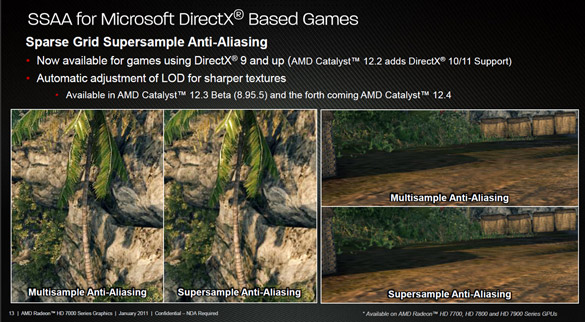AMD Radeon HD 7870 and 7850 GPU Previews
Pitcairn GPU, New Features
As we’ve mentioned, the Pitcairn GPU powering the Radeon HD 7800 series cards is based on the Graphics Core Next (GCN) architecture and has essentially the same feature set as its higher-end counterpart (Tahiti) found on the Radeon HD 7900 series.
Like Tahiti and the mainstream Cape Verde GPUs, Pitcairn is manufactured using TSMC’s advanced 28nm process node. The Pitcairn GPU, however, is comprised of roughly 2.8B transistors and outfitted with a maximum of 1,280 stream processors (to Tahiti’s 2,048) arranged in 20 compute units with 64 stream processors each. Pitcairn also sports dual Geometry engines, 32 ROPs, 80 texture units, and a 256-bit GDDR5 memory interface; double-up on Cape Verde and you've basically got Pitcairn. According to AMD, the die size of the chip is a relatively small 212 square millimeters (Tahiti is 365mm2, Cape Verde is 123mm2).
Although the Pitcairn GPU powering the Radeon HD 7800 series is pared down somewhat to hit more affordable price points, it doesn’t skimp on any features. With fewer stream processors, ROPs, and texture units, and a narrower memory interface, Pitcairn's performance will be lower than Tahiti, but its feature set remains unchanged.

Sparse Grid Supersample Anti-Aliasing

Morhpological AA 2.0 (MLAA 2.0)
While we're talking about features, we should also mention a couple of new feature additions coming with AMD's Catalyst 12.3 beta and 12.4 WHQL drivers. When those drivers hit, Radeon HD 6000 and 7000 series owners will have access to two new anti-aliasing modes. MLAA 2.0 (Morphological AA) uses an enhanced algorithm that offers better performance and image quality than the original. A new Sparse Grid Supersample AA mode will also be made available that works with DirectX 9, 10, and 11 titles. This SSAA mode will be further updated when the Catalyst 12.3 (and newer) drivers arrive, with automatic LOD adjustments to maintain sharper textures.







